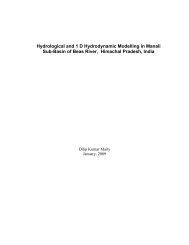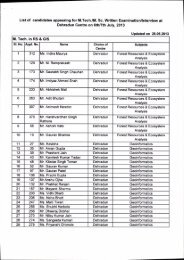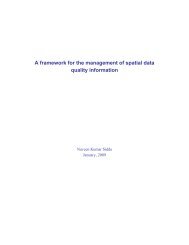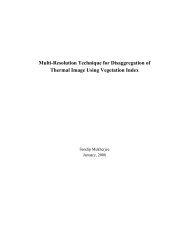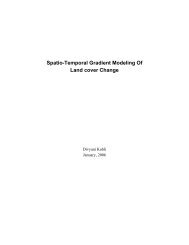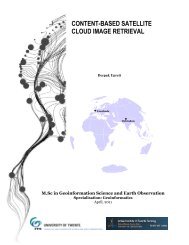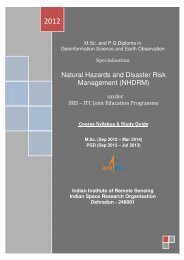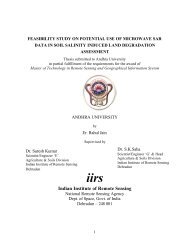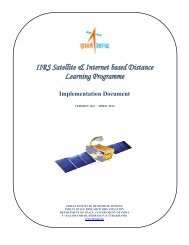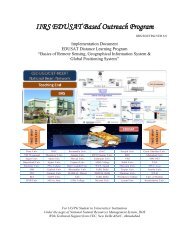IMPACT OF COAL MINING ON VEGETATION: A CASE STUDY IN JAINTIA HILLS DISTRICT OF MEGHALAYA, INDIASource: Directorate <str<strong>on</strong>g>of</str<strong>on</strong>g> M<strong>in</strong>eral Resources, Government <str<strong>on</strong>g>of</str<strong>on</strong>g> Meghalaya, 2003Table 2.3: <str<strong>on</strong>g>Coal</str<strong>on</strong>g> producti<strong>on</strong> (’000 t<strong>on</strong>nes) and percentage <strong>in</strong> Ja<strong>in</strong>tia <strong>Hills</strong> district <str<strong>on</strong>g>of</str<strong>on</strong>g> MeghalayaYear Meghalaya Ja<strong>in</strong>tia <strong>Hills</strong> % <str<strong>on</strong>g>of</str<strong>on</strong>g> the district1992-1993 3487.7 3040.80 87.181993-1994 2583.5 2062.20 79.821994-1995 3266.2 2389.70 73.161995-1996 3247.5 2159.50 66.491996-1997 3240.9 2273.60 70.151997-1998 3233.5 2414.60 74.671998-1999 4237.8 3246.10 76.591999-2000 4057.0 2935.00 72.342000-2001 4160.8 2839.80 68.252001-2002 5149.32 3869.32 75.14Total 36664.22 27230.62 74.27Source: Directorate <str<strong>on</strong>g>of</str<strong>on</strong>g> M<strong>in</strong>eral Resources, Government <str<strong>on</strong>g>of</str<strong>on</strong>g> Meghalaya, 20032.8.1. Bapung AreaBapung coalfield has the largest deposit <str<strong>on</strong>g>of</str<strong>on</strong>g> coal (34 milli<strong>on</strong> t<strong>on</strong>nes) cover<strong>in</strong>g an area <str<strong>on</strong>g>of</str<strong>on</strong>g> 12 km 2 . Twocoal seams produc<strong>in</strong>g good quality coal occur with<strong>in</strong> the undifferentiated Sylhet sandst<strong>on</strong>e <strong>in</strong> andaround Bapung (25°25' N and 91°49'E). The lower seam varies from 0.3 to 1.2m <strong>in</strong> thickness. Theupper seam is th<strong>in</strong>, and the thickness is 0.3m. The NH-44 passes through the heart <str<strong>on</strong>g>of</str<strong>on</strong>g> the coalfieldc<strong>on</strong>nect<strong>in</strong>g Shill<strong>on</strong>g and Silchar. The area represents a vast undulat<strong>in</strong>g surface with gentle slopestowards south. The general elevati<strong>on</strong> varies from 1073m to 1370m above mean sea level (Rai, 2002).The coal seams around Bapung are hard, lumpy, bright and sub-bitum<strong>in</strong>ous type. The coal shows themoisture c<strong>on</strong>tent from 2.2 to 9.2 percent, ash from 2.6 to 7.8 percent, volatile matter from 38.3 to 44.3percent, fixed carb<strong>on</strong> from 46.2 to 52.3 percent, sulphur from 3.2 to 7.1 percent and calorific valuefrom 6080 to 7494 k. cal/kg (DMR, 1985).2.8.2. Lakad<strong>on</strong>g AreaThe Lakad<strong>on</strong>g coal field cover<strong>in</strong>g the Umlatdoh (25°12'N and 92°17'E) plateau between the Myntduand Prang rivers <strong>in</strong> the southern part <str<strong>on</strong>g>of</str<strong>on</strong>g> the district. <str<strong>on</strong>g>Coal</str<strong>on</strong>g> occurrence is found around Umlatdoh andPamsaru area. The reserve <str<strong>on</strong>g>of</str<strong>on</strong>g> coal has been estimated to be 1.5 milli<strong>on</strong> t<strong>on</strong>nes and exposes a veryirregular and <strong>in</strong>c<strong>on</strong>sistent coal seam vary<strong>in</strong>g from 0.3 to 3.0m <strong>in</strong> thickness. This spreads over an area<str<strong>on</strong>g>of</str<strong>on</strong>g> 3 km 2 . The coal shows the moisture c<strong>on</strong>tent from 0.4 to 0.8 percent, ash from 2.3 to 24.7 percent,volatile matter from 29.7 to 33.5 percent, fixed carb<strong>on</strong> from 44.7 to 59.8 percent, sulphur from 3.4 to4.9 percent and calorific value from 5694 to 7500 k. cal/kg (DMR, 1985).2.8.3. Jara<strong>in</strong>-ShkentalangThe Jara<strong>in</strong>-Shkentalang area is located <strong>in</strong> the western part <str<strong>on</strong>g>of</str<strong>on</strong>g> the district. The total <strong>in</strong>ferred reserve <str<strong>on</strong>g>of</str<strong>on</strong>g>coal is 1.1 milli<strong>on</strong> t<strong>on</strong>nes cover<strong>in</strong>g an area <str<strong>on</strong>g>of</str<strong>on</strong>g> 2.8 km 2 . In Jara<strong>in</strong> there is <strong>on</strong>ly <strong>on</strong>e coal seam with athickness <str<strong>on</strong>g>of</str<strong>on</strong>g> 0.3 to 1.1m, whereas there are two coal seams <strong>in</strong> the Shkentalang coalfield that rangesfrom 0.1 to 1.0m. The coal found <strong>in</strong> the Shkentalang is bright and hard but <strong>in</strong> Jara<strong>in</strong> area coal is s<str<strong>on</strong>g>of</str<strong>on</strong>g>tand friable (GSI, 1974). The coal shows the moisture c<strong>on</strong>tent from 1.2 to 1.6 percent, ash from 4.4 to15
IMPACT OF COAL MINING ON VEGETATION: A CASE STUDY IN JAINTIA HILLS DISTRICT OF MEGHALAYA, INDIA6.7 percent, volatile matter from 41.6 to 48.1 percent, fixed carb<strong>on</strong> from 45.9 to 50.5 percent, sulphuris 2.7 percent and calorific value is 6944 k. cal/kg (DMR, 1985).2.8.4. Lumshn<strong>on</strong>gSeveral isolated exposures <str<strong>on</strong>g>of</str<strong>on</strong>g> coal have been recorded to the west and southwest <str<strong>on</strong>g>of</str<strong>on</strong>g> Lumshn<strong>on</strong>g(25°10'N and 92°23'E) over an area <str<strong>on</strong>g>of</str<strong>on</strong>g> 0.6 km 2 . The estimated reserve <str<strong>on</strong>g>of</str<strong>on</strong>g> coal <strong>in</strong> this field is 0.2milli<strong>on</strong> t<strong>on</strong>nes. The seam thickness varies from 0.3 to 0.6m (GSI, 1974). The coal seams <strong>in</strong> this areaare hard and lumpy and str<strong>on</strong>gly cok<strong>in</strong>g. The coal shows the moisture c<strong>on</strong>tent from 1.6 to 1.8 percent,ash from 3.2 to 3.8 percent, volatile matter from 30.8 to 45.5 percent, fixed carb<strong>on</strong> from 42.1 to 64.6percent and calorific value from 7250 to 8230 k. cal/kg (DMR, 1985).2.8.5. Malwar-Musiang-LamareExposure <str<strong>on</strong>g>of</str<strong>on</strong>g> coal have been recorded around Malwar (25°12'30''N and 92°24'00''E) and Musiang-Lamare (25°13'N and 92°21'E) villages over an area <str<strong>on</strong>g>of</str<strong>on</strong>g> 2.3 km 2 . The total reserve <str<strong>on</strong>g>of</str<strong>on</strong>g> coal is estimatedto be 1.1 milli<strong>on</strong> t<strong>on</strong>nes. The coal field <strong>in</strong>cludes a th<strong>in</strong>, <strong>in</strong>c<strong>on</strong>sistent coal seam, extremely variable <strong>in</strong>thickness rang<strong>in</strong>g from 0.3 to 1.6m (GSI, 1974). The coal shows the moisture c<strong>on</strong>tent from 0.6 to 3.6percent, ash from 1.3 to 21.2 percent, volatile matter from 32.6 to 40.0 percent and fixed carb<strong>on</strong> from42.1 to 60.4 percent (DMR, 1985). The coal seams <strong>in</strong> this area are hard and lumpy.2.8.6. SutngaSutnga coalfield is the eastern extensi<strong>on</strong> <str<strong>on</strong>g>of</str<strong>on</strong>g> Bapung coalfield. The coal seams occur <strong>in</strong> the Shellaformati<strong>on</strong> <str<strong>on</strong>g>of</str<strong>on</strong>g> the Paleocene age. The coal seams are <strong>in</strong>terbedded with shales and sandst<strong>on</strong>e. <str<strong>on</strong>g>Coal</str<strong>on</strong>g> isfound <strong>in</strong> two seams, the top <strong>on</strong>e be<strong>in</strong>g <strong>on</strong>ly 0.1 to 0.2m and the bottom seam varies <strong>in</strong> thickness from0.3 to 0.6m and the vertical <strong>in</strong>terval between the two seams is 3 to 5m. The total reserve <str<strong>on</strong>g>of</str<strong>on</strong>g> coal is 0.65milli<strong>on</strong> t<strong>on</strong>nes over an area <str<strong>on</strong>g>of</str<strong>on</strong>g> 0.16 km 2 . The physical characteristics <str<strong>on</strong>g>of</str<strong>on</strong>g> coal <str<strong>on</strong>g>of</str<strong>on</strong>g> this area is hard, lumpyand bright (GSI, 1974). The coal <str<strong>on</strong>g>of</str<strong>on</strong>g> Sutnga coalfield shows the moisture c<strong>on</strong>tent from 1.3 to 7.0percent, ash from 2.2 to 9.7 percent, volatile matter from 32.9 to 42.8 percent and fixed carb<strong>on</strong> from49.9 to 53.2 percent (DMR, 1985).2.8.7. IoksiIoksi is located <strong>in</strong> the eastern part <str<strong>on</strong>g>of</str<strong>on</strong>g> the district. The estimated reserve <str<strong>on</strong>g>of</str<strong>on</strong>g> coal <strong>in</strong> this area is 1.3milli<strong>on</strong> t<strong>on</strong>es cover<strong>in</strong>g an area <str<strong>on</strong>g>of</str<strong>on</strong>g> 3.6 km 2 . The thickness <str<strong>on</strong>g>of</str<strong>on</strong>g> seams varies from 0.5 to 0.9m. The coal <strong>in</strong>Ioksi area occurs <strong>in</strong> the Lower Sylhet sandst<strong>on</strong>e <str<strong>on</strong>g>of</str<strong>on</strong>g> Eocene age. The nature <str<strong>on</strong>g>of</str<strong>on</strong>g> coal deposits is beddedtype. The physical characteristics <str<strong>on</strong>g>of</str<strong>on</strong>g> coal <strong>in</strong> this area is hard, bright and jo<strong>in</strong>ted (GSI, 1974). The coal<str<strong>on</strong>g>of</str<strong>on</strong>g> Ioksi coalfield shows the moisture c<strong>on</strong>tent from 4.2 to 7.5 percent, ash from 6.0 to 18.1 percent,volatile matter from 33.0 to 43.4 percent and fixed carb<strong>on</strong> from 41.3 to 46.4 percent (DMR, 1985).2.8.8. ChyrmangAn outlier <str<strong>on</strong>g>of</str<strong>on</strong>g> the undifferentiated Sylhet sandst<strong>on</strong>e cover<strong>in</strong>g the Chyrmang (25°26'N and 92°25'E) area<strong>in</strong> the Ja<strong>in</strong>tai <strong>Hills</strong> exposes two th<strong>in</strong> seams <str<strong>on</strong>g>of</str<strong>on</strong>g> coal. The average thickness <str<strong>on</strong>g>of</str<strong>on</strong>g> the seam is 0.6m. Thecharacteristic <str<strong>on</strong>g>of</str<strong>on</strong>g> the coal is similar to that <str<strong>on</strong>g>of</str<strong>on</strong>g> the Bapung coal field. The reserve <str<strong>on</strong>g>of</str<strong>on</strong>g> coal is not fullyassessed (GSI, 1974).2.8.9. MutangMutang coal field is located <strong>in</strong> the southwest extensi<strong>on</strong> <str<strong>on</strong>g>of</str<strong>on</strong>g> the Malwar. The thickness <str<strong>on</strong>g>of</str<strong>on</strong>g> the coal seamvaries from 0.25 to 1.08m. The seam shows c<strong>on</strong>spicuous p<strong>in</strong>ch<strong>in</strong>g and swell<strong>in</strong>g.16



